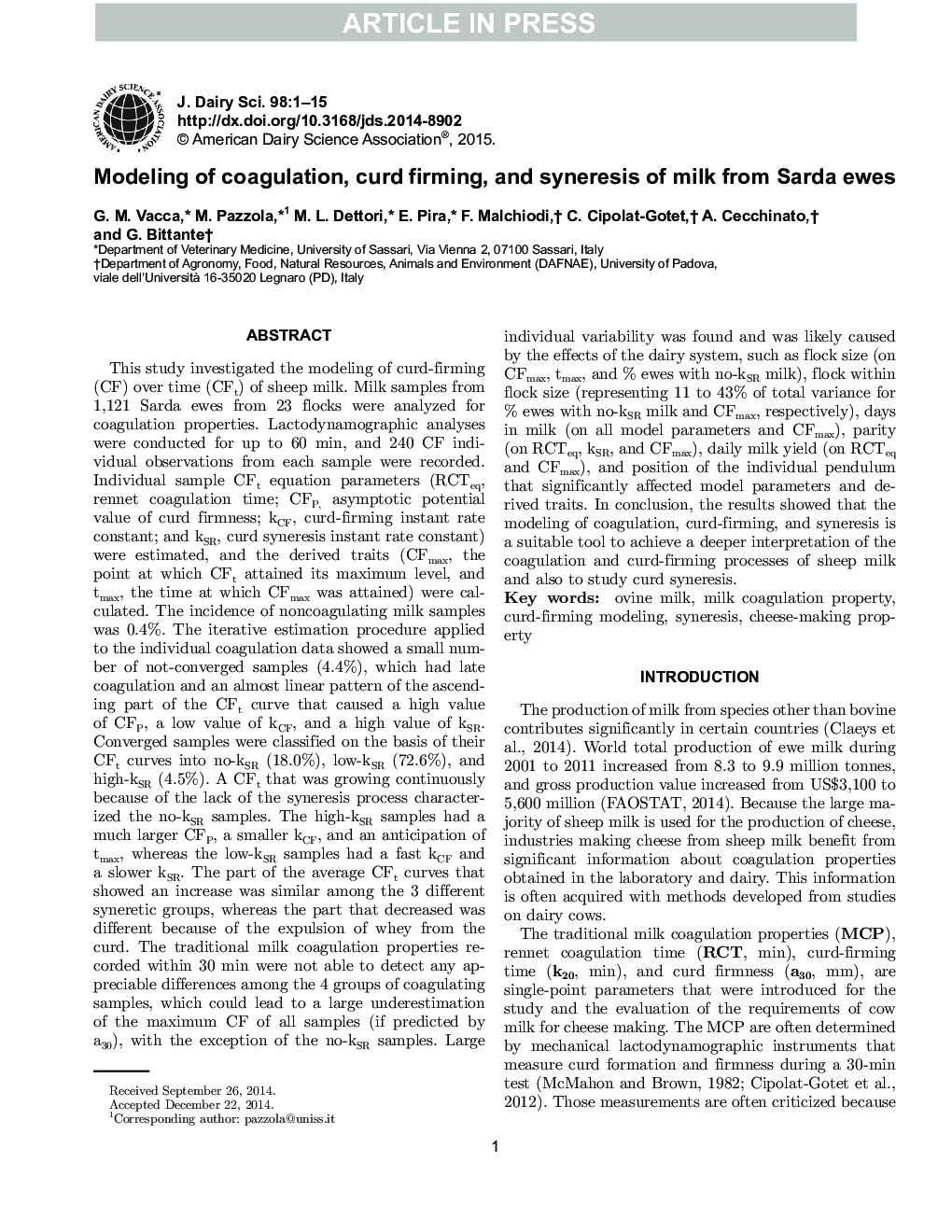| کد مقاله | کد نشریه | سال انتشار | مقاله انگلیسی | نسخه تمام متن |
|---|---|---|---|---|
| 10974725 | 1108028 | 2015 | 15 صفحه PDF | دانلود رایگان |
عنوان انگلیسی مقاله ISI
Modeling of coagulation, curd firming, and syneresis of milk from Sarda ewes
ترجمه فارسی عنوان
مدل سازی انعقاد، انقباض پنیر و همرزیم شیر از موش ساردا
دانلود مقاله + سفارش ترجمه
دانلود مقاله ISI انگلیسی
رایگان برای ایرانیان
موضوعات مرتبط
علوم زیستی و بیوفناوری
علوم کشاورزی و بیولوژیک
علوم دامی و جانورشناسی
چکیده انگلیسی
This study investigated the modeling of curd-firming (CF) over time (CFt) of sheep milk. Milk samples from 1,121 Sarda ewes from 23 flocks were analyzed for coagulation properties. Lactodynamographic analyses were conducted for up to 60Â min, and 240 CF individual observations from each sample were recorded. Individual sample CFt equation parameters (RCTeq, rennet coagulation time; CFP, asymptotic potential value of curd firmness; kCF, curd-firming instant rate constant; and kSR, curd syneresis instant rate constant) were estimated, and the derived traits (CFmax, the point at which CFt attained its maximum level, and tmax, the time at which CFmax was attained) were calculated. The incidence of noncoagulating milk samples was 0.4%. The iterative estimation procedure applied to the individual coagulation data showed a small number of not-converged samples (4.4%), which had late coagulation and an almost linear pattern of the ascending part of the CFt curve that caused a high value of CFP, a low value of kCF, and a high value of kSR. Converged samples were classified on the basis of their CFt curves into no-kSR (18.0%), low-kSR (72.6%), and high-kSR (4.5%). A CFt that was growing continuously because of the lack of the syneresis process characterized the no-kSR samples. The high-kSR samples had a much larger CFP, a smaller kCF, and an anticipation of tmax, whereas the low-kSR samples had a fast kCF and a slower kSR. The part of the average CFt curves that showed an increase was similar among the 3 different syneretic groups, whereas the part that decreased was different because of the expulsion of whey from the curd. The traditional milk coagulation properties recorded within 30Â min were not able to detect any appreciable differences among the 4 groups of coagulating samples, which could lead to a large underestimation of the maximum CF of all samples (if predicted by a30), with the exception of the no-kSR samples. Large individual variability was found and was likely caused by the effects of the dairy system, such as flock size (on CFmax, tmax, and % ewes with no-kSR milk), flock within flock size (representing 11 to 43% of total variance for % ewes with no-kSR milk and CFmax, respectively), days in milk (on all model parameters and CFmax), parity (on RCTeq, kSR, and CFmax), daily milk yield (on RCTeq and CFmax), and position of the individual pendulum that significantly affected model parameters and derived traits. In conclusion, the results showed that the modeling of coagulation, curd-firming, and syneresis is a suitable tool to achieve a deeper interpretation of the coagulation and curd-firming processes of sheep milk and also to study curd syneresis.
ناشر
Database: Elsevier - ScienceDirect (ساینس دایرکت)
Journal: Journal of Dairy Science - Volume 98, Issue 4, April 2015, Pages 2245-2259
Journal: Journal of Dairy Science - Volume 98, Issue 4, April 2015, Pages 2245-2259
نویسندگان
G.M. Vacca, M. Pazzola, M.L. Dettori, E. Pira, F. Malchiodi, C. Cipolat-Gotet, A. Cecchinato, G. Bittante,
